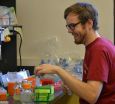(Press-News.org) MAYWOOD, Il. – Under new guidelines from the Institute of Medicine, the estimated number of children who are at risk for having insufficient or deficient levels of vitamin D is drastically reduced from previous estimates, according to a Loyola University Chicago Stritch School of Medicine study.
The study, led by Holly Kramer, MD, MPH and Ramon Durazo-Arvizu, PhD, is published online ahead of print in the Journal of Pediatric Endocrinology and Metabolism.
New Institute of Medicine guidelines say most people get sufficient vitamin D when their blood levels are at or above 20 nanograms per millilitre (ng/mL). The Pediatric Endocrine Society has a similar guideline. However, other guidelines recommend vitamin D levels above 30 ng/mL.
Loyola researchers analysed vitamin D data from a nationally representative sample of 2,877 U.S. children and adolescents ages 6 to 18 who participated in the National Health and Nutrition Examination Survey.
The study found that under the Institute of Medicine guidelines, 10.3 percent of children ages 6 to 18 are at risk of inadequate or deficient vitamin D levels. (This translates to an estimated 5.5 million children.)
By comparison, a 2009 study in the journal Pediatrics, which defined sufficient vitamin D levels as greater than 30 ng/mL, found that an estimated 70 percent of persons ages 1 to 21 had deficient or insufficient vitamin D levels.
Under previous guidelines, millions of children who had vitamin D levels between 20 and 30 ng/mL would have needed supplementation. Under the Institute of Medicine guidelines, children in this range no longer need to take vitamin D supplements.
The new study found that children at risk of vitamin D deficiency under the Institute of Medicine guidelines are more likely to be overweight, female, non-white and between the ages of 14 and 18.
The Institute of Medicine's new vitamin D guidelines are based on nearly 1,000 published studies and testimony from scientists and other experts. The IOM found that vitamin D is essential to avoid poor bone health, such as rickets. But there have been conflicting and mixed results in studies on whether vitamin D can also protect against cancer, heart disease, autoimmune diseases and diabetes. Moreover, excessive vitamin D can damage the kidneys and heart, the IOM found.
INFORMATION:The Loyola study is titled "Prevalence of risk of deficiency and inadequacy of 25-hydroxyvitamin D in US Children: NHANES 2003-2006."
Authors of the Loyola study work in the departments of Public Health Sciences and Pediatrics. In addition to Kramer and Durazo-Arvizu, they are Vytas P. Karalius, MPH, MA (first author); Daniel Zinn, MD; James Wu, MD; Guichan Cao, PhD; Carla Minutti, MD and Amy Luke, PhD.
Fewer children at risk for deficient vitamin D
Under new guidelines, only 10.3 percent have inadequate levels, study finds
2014-03-25
ELSE PRESS RELEASES FROM THIS DATE:
Black markets for hackers are increasingly sophisticated, specialized and maturing
2014-03-25
Black and gray markets for computer hacking tools, services and byproducts such as stolen credit card numbers continue to expand, creating an increasing threat to businesses, governments and individuals, according to a new RAND Corporation study.
One dramatic example is the December 2013 breach of retail giant Target, in which data from approximately 40 million credit cards and 70 million user accounts was hijacked. Within days, that data appeared -- available for purchase -- on black market websites.
"Hacking used to be an activity that was mainly carried out by individuals ...
Lick's new Automated Planet Finder: First robotic telescope for planet hunters
2014-03-25
Lick Observatory's newest telescope, the Automated Planet Finder (APF), has been operating robotically night after night on Mt. Hamilton since January, searching nearby stars for Earth-sized planets. Every night the fully autonomous system checks the weather, decides which stars to observe, and moves the telescope from star to star throughout the night, collecting measurements that will reveal the presence of planets. Its technical performance has been outstanding, making it not only the first robotic planet-finding facility but also one of the most sensitive.
The search ...
Stink bug traps may increase damage to tomato fruits
2014-03-25
The invasive brown marmorated stink bug (Halyomorpha halys) is an important pest of fruits and vegetables. To counter them, some home gardeners use pheromone-baited traps that are designed to attract, trap, and kill them. However, new research from entomologists at the University of Maryland suggests that the traps may actually increase stink bug damage to tomatoes. The research will appear in the April issue of Environmental Entomology (DOI: http://dx.doi.org/10.1603/EN13237).
The researchers asked 15 gardeners to place stink bug traps at the ends of rows of tomatoes, ...
New method yields potent, renewable human stem cells with promising therapeutic properties
2014-03-25
New Rochelle, NY, March 24, 2014—The curative and therapeutic potential of mesenchymal stem cells (MSCs) offers much promise, as these multipotent cells are currently being tested in more than 300 clinical trials in a range of diseases. A new, easier, and more reliable way to make large quantities of highly potent MSCs could accelerate progress toward their use in regenerative medicine, as described in an article in Stem Cells and Development, a peer-reviewed journal from Mary Ann Liebert, Inc., publishers. The article is available on the Stem Cells and Development website.
Robert ...
The fundamentals of facial recognition
2014-03-25
When it comes to recognizing faces, humans are extraordinarily skillful. It's no surprise – after all, from the moment humans leave the womb, the infant brains already have a preference for faces, and over the course of a lifetime, the average person sees hundreds of thousands of faces.
Among scientists, however, the question of exactly how humans came to possess this amazing ability remains a divisive one, with some researchers claiming our extraordinary abilities result from the operation of mechanisms specialized just for faces, whereas others argue that recognition ...
Study finds gout drug may reduce risk of death
2014-03-25
(Boston)--In a recently to be published study in Annals of the Rheumatic Diseases, researchers have found the use of the drug allopurinol was associated with a reduced risk of death in hyperuricemic (gout) patients. The study, the first in a general population, has found the overall benefit of allopurinol on survival may outweigh the impact of rare serious adverse effects.
Researchers from the Section of Rheumatology and Clinical Epidemiology at Boston University School of Medicine (BUSM) contributed to this study.
Gout has been associated with an increased risk of ...
NOAA led study: Crude oil causes developmental abnormalities in large marine fish
2014-03-25
Crude oil from the 2010 Deepwater Horizon disaster causes severe defects in the developing hearts of bluefin and yellowfin tunas, according to a new study by a team of NOAA and academic scientists.
The findings, published in the Proceedings of the National Academy of Sciences on the 25th anniversary of the Exxon Valdez oil spill, show how the largest marine oil spill in United States history may have affected tunas and other species that spawned in oiled offshore habitats in the northern Gulf of Mexico.
Atlantic bluefin tuna, yellowfin tuna, and other large predatory ...
For neurons in the brain, identity can be used to predict location
2014-03-25
Cold Spring Harbor, NY – Throughout the world, there are many different types of people, and their identity can tell a lot about where they live. The type of job they work, the kind of car they drive, and the foods they eat can all be used to predict the country, the state, or maybe even the city a person lives in.
The brain is no different. There are many types of neurons, defined largely by the patterns of genes they use, and they "live" in numerous distinct brain regions. But researchers do not yet have a comprehensive understanding of these neuronal types and how ...
Scientists find a molecular clue to the complex mystery of auxin signaling in plants
2014-03-25
Wikipedia lists 65 adjectives that botanists use to describe the shapes of plant leaves. In English (rather than Latin) they mean the leaf is lance-shaped, spear-shaped, kidney-shaped, diamond shaped, arrow-head-shaped, egg-shaped, circular, spoon-shaped , heart-shaped, tear-drop-shaped or sickle-shaped — among other possibilities.
How does the plant "know" how to make these shapes? The answer is by controlling the distribution of a plant hormone called auxin, which determines the rate at which plant cells divide and lengthen.
But how can one molecule make so many ...
Innovative technique provides inexpensive, rapid and detailed analysis of proteins
2014-03-25
Proteins are vital participants in virtually all life processes, including growth, repair and signaling in cells; catalysis of chemical reactions and defense against infection. For these reasons, proteins can provide critical signposts of health and disease, provided they can be identified and assessed in a clinical setting.
Accurately characterizing proteins for diagnostic and therapeutic purposes has been an enormous challenge for the medical community. At the Biodesign Institute's Molecular Biomarkers Laboratory at Arizona State University, research focuses on the ...
LAST 30 PRESS RELEASES:
Tracing the quick synthesis of an industrially important catalyst
New software sheds light on cancer’s hidden genetic networks
UT Health San Antonio awarded $3 million in CPRIT grants to bolster cancer research and prevention efforts in South Texas
Third symposium spotlights global challenge of new contaminants in China’s fight against pollution
From straw to soil harmony: International team reveals how biochar supercharges carbon-smart farming
Myeloma: How AI is redrawing the map of cancer care
Manhattan E. Charurat, Ph.D., MHS invested as the Homer and Martha Gudelsky Distinguished Professor in Medicine at the University of Maryland School of Medicine
Insilico Medicine’s Pharma.AI Q4 Winter Launch Recap: Revolutionizing drug discovery with cutting-edge AI innovations, accelerating the path to pharmaceutical superintelligence
Nanoplastics have diet-dependent impacts on digestive system health
Brain neuron death occurs throughout life and increases with age, a natural human protein drug may halt neuron death in Alzheimer’s disease
SPIE and CLP announce the recipients of the 2025 Advanced Photonics Young Innovator Award
Lessons from the Caldor Fire’s Christmas Valley ‘Miracle’
Ant societies rose by trading individual protection for collective power
Research reveals how ancient viral DNA shapes early embryonic development
A molecular gatekeeper that controls protein synthesis
New ‘cloaking device’ concept to shield sensitive tech from magnetic fields
Researchers show impact of mountain building and climate change on alpine biodiversity
Study models the transition from Neanderthals to modern humans in Europe
University of Phoenix College of Doctoral Studies releases white paper on AI-driven skilling to reduce burnout and restore worker autonomy
AIs fail at the game of visual “telephone”
The levers for a sustainable food system
Potential changes in US homelessness by ending federal support for housing first programs
Vulnerability of large language models to prompt injection when providing medical advice
Researchers develop new system for high-energy-density, long-life, multi-electron transfer bromine-based flow batteries
Ending federal support for housing first programs could increase U.S. homelessness by 5% in one year, new JAMA study finds
New research uncovers molecular ‘safety switch’ shielding cancers from immune attack
Bacteria resisting viral infection can still sink carbon to ocean floor
Younger biological age may increase depression risk in older women during COVID-19
Bharat Innovates 2026 National Basecamp Showcases India’s Most Promising Deep-Tech Ventures
Here’s what determines whether your income level rises or falls
[Press-News.org] Fewer children at risk for deficient vitamin DUnder new guidelines, only 10.3 percent have inadequate levels, study finds




